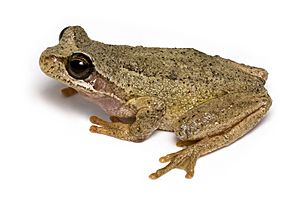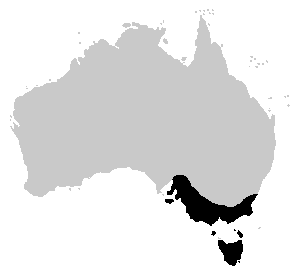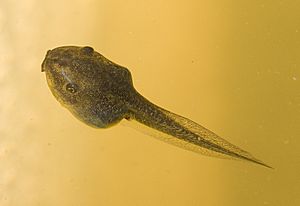Southern brown tree frog facts for kids
Quick facts for kids Southern brown tree frog |
|
|---|---|
 |
|
| Conservation status | |
| Scientific classification | |
 |
|
| Native distribution of the southern brown tree frog |
The southern brown tree frog (Litoria ewingii) is a small frog found in Australia. It's also known by other names like the brown tree frog, whistling tree frog, or Ewing's tree frog. These frogs are native to many parts of southern Australia, including Victoria, South Australia, New South Wales, and all of Tasmania. They are the most common frog in Tasmania. This species has also been introduced to New Zealand, where it can be found in large numbers in some areas.
Contents
About the Southern Brown Tree Frog
This frog was first described in 1841 by two French naturalists, André Duméril and Gabriel Bibron.
What Does This Frog Look Like?
The southern brown tree frog can grow up to about 4.5 centimeters (1.8 inches) long. Its skin is usually light to dark brown on its back. It often has a darker patch that starts near its eyes and covers most of its back. Some frogs of this species can even be pure green or have green stripes!
A dark stripe runs from its nose, across its eye, and over its ear drum (tympanum) to its shoulder. Below this, a pale white stripe goes from its mouth to its arm. The backs of its thighs are orange. Unlike some similar frogs, it usually doesn't have black patterns on its thighs.
Its belly is a creamy white color. Frogs from western Victoria and southeastern South Australia might be partly or completely green.
Where Do These Frogs Live?
You can find the southern brown tree frog in many different places. They live in forests, on farms, in heathlands, and even in drier areas. They also live in cold, high mountain regions and in suburban neighborhoods.
They are very common in cities like Adelaide, Melbourne, and Hobart. You might even see them on windows at night. They are attracted to the lights because flying insects gather there, which the frogs like to eat.
Frog Behavior and Sounds
Male southern brown tree frogs make a special "weep-weep-weep" sound. They call from next to or floating in water. You can hear them near dams, ditches, ponds, and pools beside streams. They call all year round, especially after it rains.
When these frogs lay eggs, they wrap them around submerged grass stems, water plants, and sticks. These eggs are easy to spot.
An amazing fact about these frogs is that they can actually freeze and survive!
Keeping a Southern Brown Tree Frog as a Pet
In Australia, you can keep a southern brown tree frog as a pet without needing a special wildlife license, as long as you get it from a breeder.
These frogs do not need special UV light. They just need a regular light cycle (day and night) and a small source of water. Since they are tree frogs, they like to climb.
See also
 In Spanish: Litoria ewingii para niños
In Spanish: Litoria ewingii para niños




